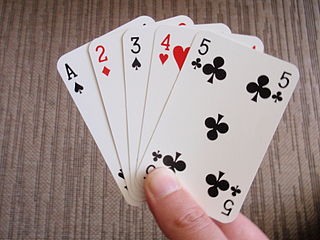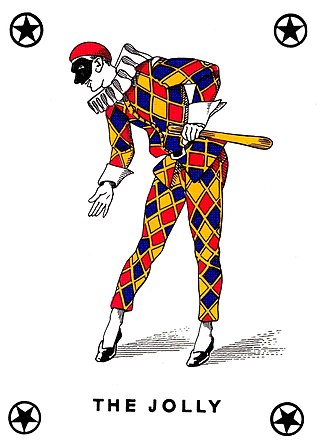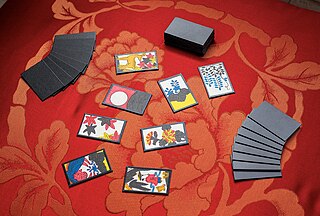
A playing card is a piece of specially prepared card stock, heavy paper, thin cardboard, plastic-coated paper, cotton-paper blend, or thin plastic that is marked with distinguishing motifs. Often the front (face) and back of each card has a finish to make handling easier. They are most commonly used for playing card games, and are also used in magic tricks, cardistry, card throwing, and card houses; cards may also be collected. Playing cards are typically palm-sized for convenient handling, and usually are sold together in a set as a deck of cards or pack of cards.
A stripped deck or short deck (US), short pack or shortened pack (UK), is a set of playing cards reduced in size from a full pack or deck by the removal of a certain card or cards. The removed cards are usually pip cards, but can also be court cards or Tarot cards. Many card games use stripped decks, and stripped decks for popular games are commercially available.

An ace is a playing card, die or domino with a single pip. In the standard French deck, an ace has a single suit symbol located in the middle of the card, sometimes large and decorated, especially in the case of the ace of spades. This embellishment on the ace of spades started when King James VI of Scotland and I of England required an insignia of the printing house to be printed on the ace of spades. This insignia was necessary for identifying the printing house and stamping it as having paid the new stamp tax. Although this requirement was abolished in 1960, the tradition has been kept by many card makers. In other countries the stamp and embellishments are usually found on ace cards; clubs in France, diamonds in Russia, and hearts in Genoa because they have the most blank space.

The Joker is a playing card found in most modern French-suited card decks, as an addition to the standard four suits. Since the second half of the 20th century, they have also been found in Spanish- and Italian-suited decks, excluding stripped decks.

During the 2003 invasion of Iraq by a United States–led coalition, the U.S. Defense Intelligence Agency developed a set of playing cards to help troops identify the most-wanted members of President Saddam Hussein's government, mostly high-ranking members of the Iraqi Regional Branch of the Arab Socialist Ba'ath Party or members of the Revolutionary Command Council; among them were some of Hussein's family members. The cards were officially named the "personality identification playing cards". As of 2021, all but four of the 52 most wanted have either died or been captured, eleven of whom have been released.

The United States Playing Card Company is a large American producer and distributor of playing cards. It was established in 1867 as Russell, Morgan & Co. and founded in Cincinnati, Ohio in its current incarnation in 1885. Its many brands include Bicycle, Bee, Tally-Ho, Champion, Congress, Aviator, Aristocrat, Mohawk, Maverick, KEM, Hoyle and Fournier. It also produces novelty and custom playing cards, and other playing card accessories such as poker chips. For decades the company was based in Norwood, Ohio, but as of 2009, the USPC is currently headquartered in the Cincinnati suburb of Erlanger, Kentucky.

Hanafuda are a type of Japanese playing cards. They are typically smaller than Western playing cards, only 5.4 by 3.2 cm, but thicker and stiffer, and often with a pronounced curve. On the face of each card is a depiction of plants, tanzaku (短冊), animals, birds, or man-made objects. One single card depicts a human. The back side is usually plain, without a pattern or design of any kind, and traditionally coloured either red or black. Hanafuda are used to play a variety of games including Koi-Koi and Hachi-Hachi.

The king is a playing card with a picture of a king displayed on it. The king is usually the highest-ranking face card. In the French version of playing cards and tarot decks, the king immediately outranks the queen. In Italian and Spanish playing cards, the king immediately outranks the knight. In German and Swiss playing cards, the king immediately outranks the Ober. In some games, the king is the highest-ranked card; in others, the Ace is higher. Aces began outranking kings around 1500 with Trappola being the earliest known game in which the aces were highest in all four suits. In the ace–ten family of games such as pinochle and Schnapsen, both the ace and the 10 rank higher than the king.

The ace of spades is traditionally the highest and most valued card in the deck of playing cards. The actual value of the card varies from game to game.

The standard 52-card deck of French-suited playing cards is the most common pack of playing cards used today. In English-speaking countries it is the only traditional pack used for playing cards; in many countries of the world, however, it is used alongside other traditional, often older, standard packs with different suit systems such as those with German-, Italian-, Spanish- or Swiss suits. The most common pattern of French-suited cards worldwide and the only one commonly available in English-speaking countries is the English pattern pack. The second most common is the Belgian-Genoese pattern, designed in France, but whose use spread to Spain, Italy, the Ottoman Empire, the Balkans and much of North Africa and the Middle East. In addition to those, there are other major international and regional patterns including standard 52-card packs, for example, in Italy that use Italian-suited cards. In other regions, such as Spain and Switzerland, the traditional standard pack comprises 36, 40 or 48 cards.

Doomtown: Reloaded is an expandable card game based on the Deadlands role-playing game. It was originally a collectible card game that ran from 1998 through 2001 and was revived as the Reloaded version in 2014. It was published by Wizards of the Coast (WotC) under license to Pinnacle Entertainment Group until January 2000, when WotC quit production and the license transferred to Alderac Entertainment Group.

A four-color deck (US) or four-colour pack (UK) is a deck of playing cards identical to the standard French deck except for the color of the suits. In a typical English four-color deck, hearts are red and spades are black as usual, but clubs are green and diamonds are blue. However, other color combinations have been used over the centuries, in other areas or for certain games.

Playing cards have been in Italy since the late 14th century. Until the mid 19th century, Italy was composed of many smaller independent states which led to the development of various regional patterns of playing cards; "Italian suited cards" normally only refer to cards originating from northeastern Italy around the former Republic of Venice, which are largely confined to northern Italy, parts of Switzerland, Dalmatia and southern Montenegro. Other parts of Italy traditionally use traditional local variants of Spanish suits, French suits or German suits.

Spades is one of the four playing card suits in the standard French-suited playing cards. It has the same shape as the leaf symbol in German-suited playing cards but its appearance is more akin to that of an upside down black heart with a stalk at its base. It symbolises the pike or halberd, two medieval weapons, but is actually an adaptation of the German suit symbol of Leaves created when French suits were invented around 1480.
Stud poker is any of a number of poker variants in which each player receives a mix of face-down and face-up cards dealt in multiple betting rounds. Stud games are also typically non-positional games, meaning that the player who bets first on each round may change from round to round. The cards dealt face down to each individual player are called hole cards, which gave rise to the common English expression ace in the hole for any hidden advantage.

Parts of Swiss German speaking Switzerland have their own deck of playing cards referred to as Swiss-suited playing cards or Swiss-suited cards. They are mostly used for Jass, the "national card game" of Switzerland. The deck is related to the various German playing cards. Within Switzerland, these decks are called German or Swiss German cards.

German-suited playing cards are a very common style of traditional playing card used in many parts of Central Europe characterised by 32- or 36-card packs with the suits of Acorns, Leaves, Hearts and Bells. The German suit system is one of the oldest, becoming standard around 1450 and, a few decades later, influencing the design of the now international French suit system of Clubs, Spades, Hearts and Diamonds. Today German-suited playing cards are common in south and east Germany, Austria, German-speaking Switzerland, Liechtenstein, north Italy, Hungary, Czech Republic, Slovakia, Slovenia, Croatia, Bosnia, northern Serbia, southern Poland and central and western Romania.

French-suited playing cards or French-suited cards are cards that use the French suits of trèfles, carreaux, cœurs, and piques. Each suit contains three or four face/court cards. In a standard 52-card deck these are the valet, the dame, and the roi (king). In addition, in Tarot packs, there is a cavalier (cavalier) ranking between the queen and the jack. Aside from these aspects, decks can include a wide variety of regional and national patterns, which often have different deck sizes. In comparison to Spanish, Italian, German, and Swiss playing cards, French cards are the most widespread due to the geopolitical, commercial, and cultural influence of France, the United Kingdom, and the United States in the 19th and 20th centuries. Other reasons for their popularity were the simplicity of the suit insignia, which simplifies mass production, and the popularity of whist and contract bridge. The English pattern of French-suited cards is so widespread that it is also known as the International or Anglo-American pattern.

As-Nas is a card game or type of playing cards that were used in Persia.
Five-suit bridge is a late 1930s variation of contract bridge played with a deck of 65 playing cards divided into five suits.



















